Construction Forms and Seismic Performance of the Ancient Chinese Buildings Joined by Tenon–Mortise Joints
Abstract
:1. Introduction
2. Materials and Methods
2.1. The Concept of the Tenon-Mortise Joint and Its Development
2.2. Classification of Tenon-Mortise Joints
2.2.1. Tenon–Mortise Joints for Fixing Vertical Structural Components
2.2.2. Tenon–Mortise Joints for Joining Horizontal and Vertical Structural Components
- (1)
- Steamed-bread tenon: a tenon used to perpendicularly join the top end of a column to one end of a beam, its function lies in preventing the horizontal displacement of the beam, as shown in Figure 5a.
- (2)
- Dovetail tenon: a tenon commonly used for joining the other horizontal structural components, except the beams to the top end of a column, such as the eave tie beam connecting the eave columns (the outmost column), and the purlin tie beam connecting the hypostyle columns (within the eave column, all the other columns except the ones in the axis of the building), as shown in Figure 5b.
- (3)
- Beam end-locking tenon: a special tenon that joins two tie-beams and a column at an end or a corner, and is supposed to lock the column tightly. The use of such tenons brings a strong tying force to the corner column and protects the column at the same time, as shown in Figure 5c.
- (4)
- Through tenon: a tenon often made in the form of a “big tongue to enter and small tongue to protrude” at the end of a penetrating tie beam, which connects two columns in a row, as shown in Figure 5d.
- (5)
- Half tenon: as its applicable part is similar to a through tenon, it is only used when a through tenon is not suitable, such as when joining the center column and the beam, as shown in Figure 5e.
2.2.3. Tenon–Mortise Joints for Joining Intersecting Horizontal Structural Components
- (1)
- Cross-shaped notched round tenon: a tenon mainly used to join cross-intersecting round-shaped or linear structural components, as shown in Figure 6a.
- (2)
- Cross-shaped notched square tenon: a tenon mainly used to join cross-intersecting square-shaped structural components, mainly used for planar tie beams (specially created to support the Dougong bracket), as shown in Figure 6b.
2.2.4. Tenon–Mortise Joints for Overlapping or Semi-Overlapping Horizontal or Inclined Structural Components
- (1)
- Bowl for purlin: the joint for placing a purlin, located on top of the king post or beams, as shown in Figure 7a.
- (2)
- Tenon at the beam end: a tenon mostly used in the extended joining of a hip rafter with an inverted v-shaped brace. The combination of them supports the wing angle, a special form of ancient Chinese architecture to prevent rain from dampening the walls, as shown in Figure 7b.
- (3)
- Stepped tenon on the beam: a tenon mostly used for joining a short lying beam and a long lying beam. The lying beam is a type of beam lying on another beam, acting as a tie-beam, as shown in Figure 7c.
2.2.5. Tenon–Mortise Joints for Joining Boards
- (1)
- Silver-ingot opening: also known as the silver-ingot tenon, this is wide at both ends but slender in the center and so named for its shape, which resembles a silver ingot. It is most often used for joining solid boards, as shown in Figure 8a.
- (2)
- Chuandai (belting through) tenon: this tenon runs through the dovetail tongue made on the back of glued boards and can prevent the unevenness of the board surface caused by deformation, as shown in Figure 8b.
- (3)
- Dragon and phoenix tenon: a slot is made along one joining side of the board, and a groove is made along another joining side. Then, the two boards are joined together, as shown in Figure 8c.
- (4)
- Rabbeted joint: the edges of the board are rabbeted and then joined. This joint is often used in gable boards, as shown in Figure 8d.
- (5)
- Chaoshoudai: this tenon is one form of Chuandai, in which a hole is made through the width of the board. It is mainly used on thick wooden doors, as shown in Figure 8e.
2.3. Dougong Bracket
3. Results and Discussion
3.1. Scale Model Test
3.2. Analysis of Seismic Principle
4. Conclusions
Author Contributions
Funding
Institutional Review Board Statement
Informed Consent Statement
Data Availability Statement
Conflicts of Interest
References
- Xin, C. Study on the Tenon-Mortise Joint Construction of Traditional Chinese Wood Structures; Beijing Forestry University Press: Beijing, China, 2012. [Google Scholar]
- Hu, Y.N.; Yang, Y.S. Study on the node connection mode of light wood structure. Urban Archit. Space 2021, 28, 143–145. [Google Scholar]
- Ohya, S.; Tanaka, K. Effects of moisture content change on the strength of mortise-and-tenon joints. J. Hokkaido Univ. Educ. Nat. Sci. 2008, 58, 53–60. [Google Scholar]
- Song, H. How Did the Ancients Build Houses Without Nails? Why Is It So Strong? The Wisdom of the Ancients Was Too High? China. Available online: https://www.sohu.com/a/545449150_100183782?scm=1019.e000a.v1.0&spm=smpc.csrpage.news-list.1.1658487423628w3zy46K (accessed on 10 October 2018).
- Song, H. Evolution of 7000-Year Tenon-Mortise Joinery, China. web/20191029031908. Available online: https://baijiahao.baidu.com/s?id=1618997223549427779 (accessed on 5 December 2018).
- Zhang, X.C. Dynamic Analysis of Ancient Timber–Frame Buildings under Seismic Excitations; Xi’an University of Architecture and Technology: Xi’an, China, 2014. [Google Scholar]
- Ma, L.L.; Xue, J.Y.; Zhang, X.C.; Geng, S.B. Seismic responses of ancient timber structures with looseness mortise-tenons. J. Vib. Eng. 2022; in press. [Google Scholar]
- Chen, L.K.; Li, S.C.; Wang, Y.T.; Zhao, Y.J.; Zhang, M.; Song, X.Y.; Li, X.W.; Wu, T.; Jiang, L.Z. Experimental study on the seismic behaviour of mortise–tenon joints of the ancient timbers. Struct. Eng. Int. 2017, 27, 512–519. [Google Scholar] [CrossRef]
- Chun, Q.; Yue, Z.; Pan, J. Experimental study on seismic characteristics of typical mortise-tenon joints of Chinese southern traditional timber frame buildings. China Technol. Sci. 2011, 54, 2404. [Google Scholar] [CrossRef]
- Zhou, W.; Ji, Y. Shanxi Sakata: One of the World’s Three Major Strange Towers. Available online: http://jingguan.yuanlin.com/scene/building/2017-12-28/28635.html (accessed on 28 December 2018).
- Dan, M. On the development history and current situation of tenon-mortise joinery. J. Apprec. 2016, 8, 339. [Google Scholar]
- Su, J.P. Traditional Wood Technics-Tenon-Mortise History, China. web/20191029031808. 21 February 2018. Available online: http://www.naic.org.cn/html/2017/gjjg_0914/21444.html (accessed on 28 December 2018).
- Luo, Z.W. History of Ancient Chinese Architecture; Shanghai Ancient Works Publishing House: Shanghai, China, 1990. [Google Scholar]
- Ma, B.J. Wooden Construction Technology of Ancient Chinese Architecture; Science Press: Beijing, China, 2003. [Google Scholar]
- Mu, N. Passing through Six Hundred Years, the Hidden Forbidden City Secrets You Do Not Know, China. Available online: http://www.360doc.cn/article/40167318_723249350.html (accessed on 7 August 2018).
- Zhou, Q.; Yan, W.M.; Ji, J.B.; Yang, N. Shaking table tests of an ancient Chinese building with a single layer gableand a hip roof. Sci. Conserv. Archaeol. 2018, 30, 37–52. [Google Scholar]
- Zhou, Q.; Yan, W.M.; Yang, N.; Ji, J.B. Experimental investigation of seismic performance of single layer gable and hip roof type of Chinese ancient building under high intensity earthquake. China Civ. Eng. J. 2018, 51, 32–36. [Google Scholar]
- Zhang, X.C. Dynamic Analysis of Ancient Wooden Structures under Earthquake. Ph.D. Thesis, Xi’an University of Architecture and Technology, Xi’an, China, 2013. [Google Scholar]
- Sha, B.; Wang, H.; Li, A. The influence of the damage of mortise-tenon joint on the cyclic performance of the traditional Chinese timber frame. Appl. Sci. 2019, 9, 3429. [Google Scholar] [CrossRef] [Green Version]
- Sui, Y.; Zhao, H.T.; Xue, J.Y.; Zhang, H.Y.; Xie, Q.F. Experimental study on characteristics of mortise-tenon joints in historic timber buildings. World Earth Quake Eng. 2010, 26, 88–92. [Google Scholar]
- Li, X.W.; Zhao, J.H.; Ma, G.W.; Huang, S.H. Experimental study on the traditional timber mortise-tenon joints. Adv. Struct. Eng. 2015, 18, 2089–2102. [Google Scholar] [CrossRef]
- Zhang, Y.N.; Nehdi, M.L.; Gao, X.H.; Zhang, L.V. Flexural performance of novel nail-cross-laminated timber composite panels. Appl. Sci. 2020, 10, 5983. [Google Scholar] [CrossRef]
- Ramirez Ortiz, C.; Areiza Palma, G.; Gutierrez Amador, A.D.; Ramirez Duque, J.L.; Cano Buitron, R.E.; Gonzales Escobar, L.F. Seismic behavior of a steel beam-to-concrete-filled steel tubular column connection using external diaphragms. Appl. Sci. 2022, 12, 3618. [Google Scholar] [CrossRef]
- Zeng, Y.H.; Huang, Y.; Sun, Z.Y. A probabilistic framework for robustness quantification of precast concrete frames under seismic loading. Appl. Sci. 2022, 12, 3814. [Google Scholar] [CrossRef]
- Dominika, P.; Tomasz, M. Numerical analysis of steel geodesic dome under seismic excitations. Materials 2021, 14, 4493. [Google Scholar] [CrossRef]
- Todorovska, M.I.; Mihailo, D. Impulse response analysis of the Van Nuys 7-storey hotel during 11 earthquakes and earthquake damage detection. Struct. Control. Health Monit. 2008, 15, 90–116. [Google Scholar] [CrossRef]
- Wu, G.F.; Gong, M.; Gong, Y.C.; Ren, H.Q.; Zhong, Y. Mechanical performance of mortise and tenon joints pre-reinforced with slot-in bamboo scrimber plates. J. Wood Sci. 2019, 65, 38. [Google Scholar] [CrossRef] [Green Version]
- Chen, C.; Li, G.; Shen, Q.; Jiang, B. Experimental study on positive and reverse flexural behavior of asymmetric mortise-tenon joints. Appl. Mech. Mater. 2014, 578–579, 160–163. [Google Scholar]
- Cui, H.; Shi, B.X.; Cong, Y.; Lan, D. Seismic properties of mortise and tenon nodes of ancient wood structure. Sci. Technol. Vis. 2022, 10, 64–66. [Google Scholar]
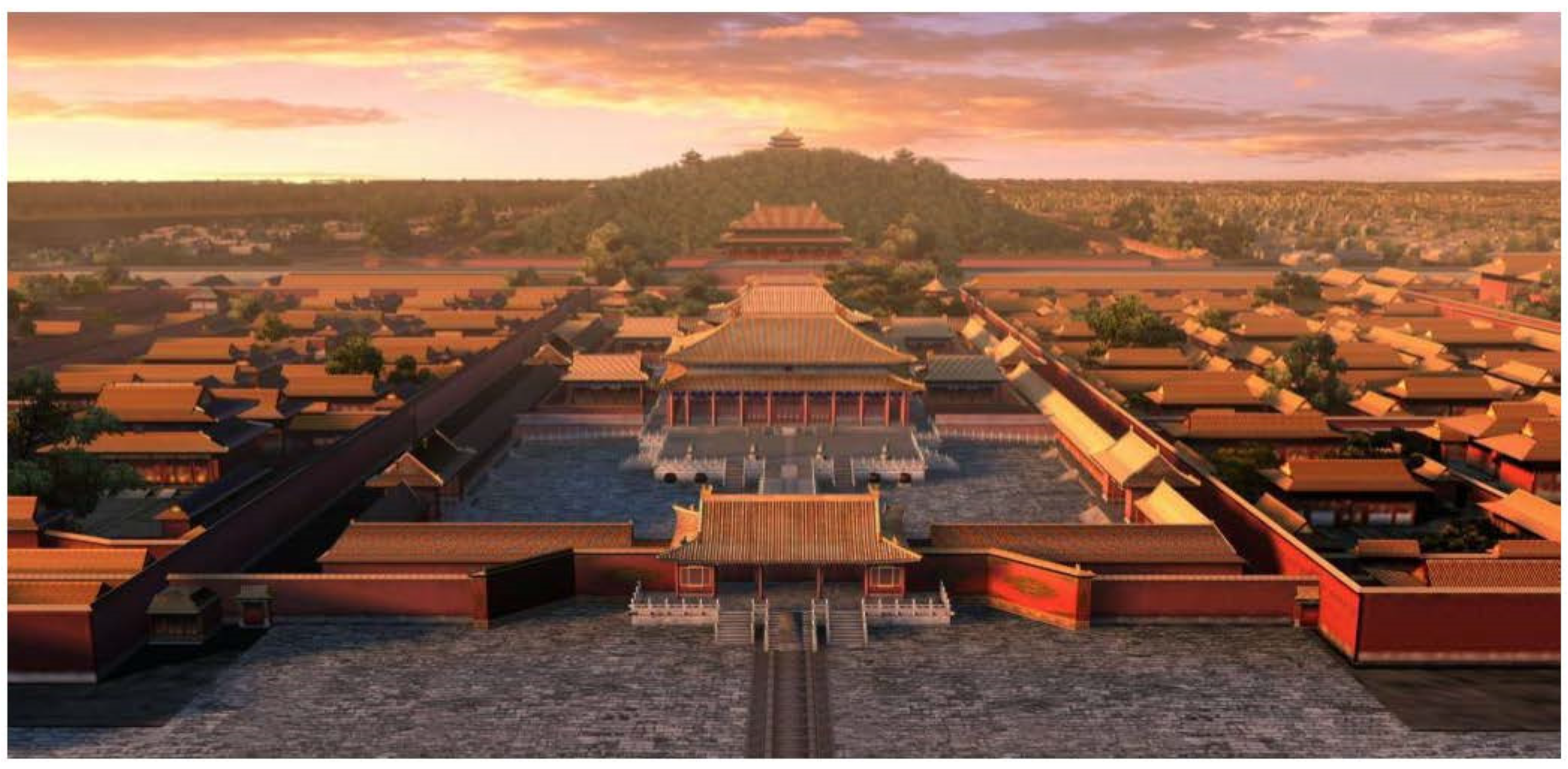



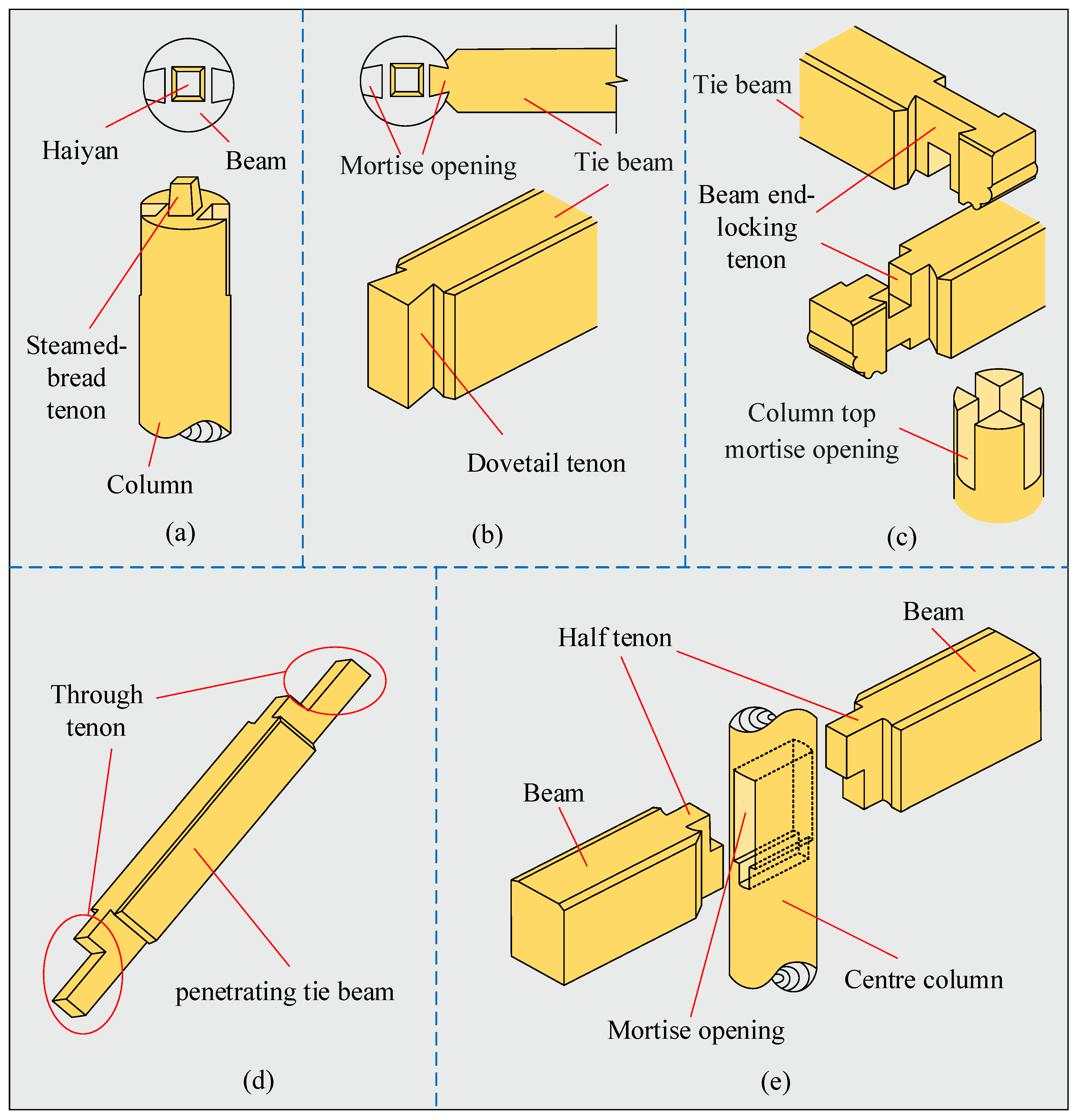

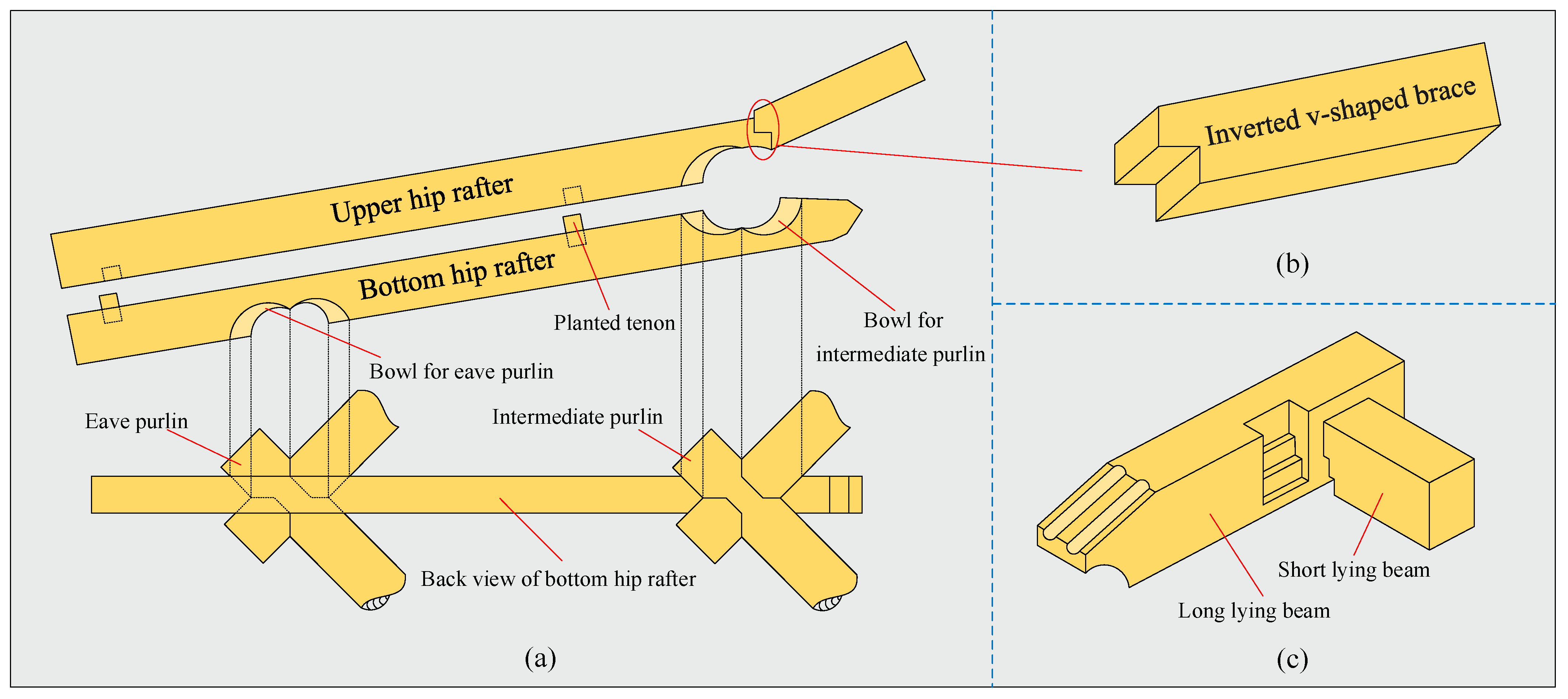
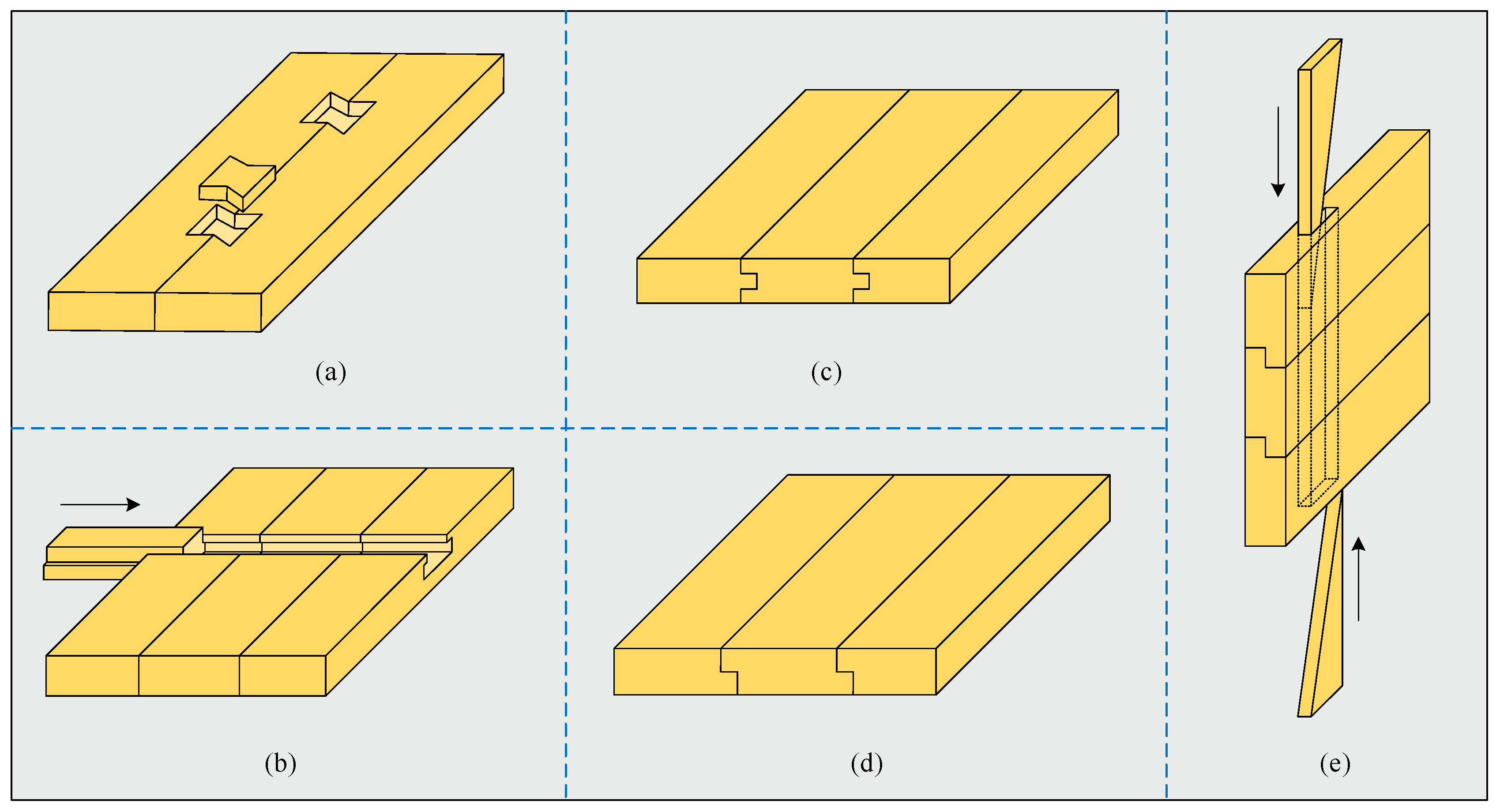


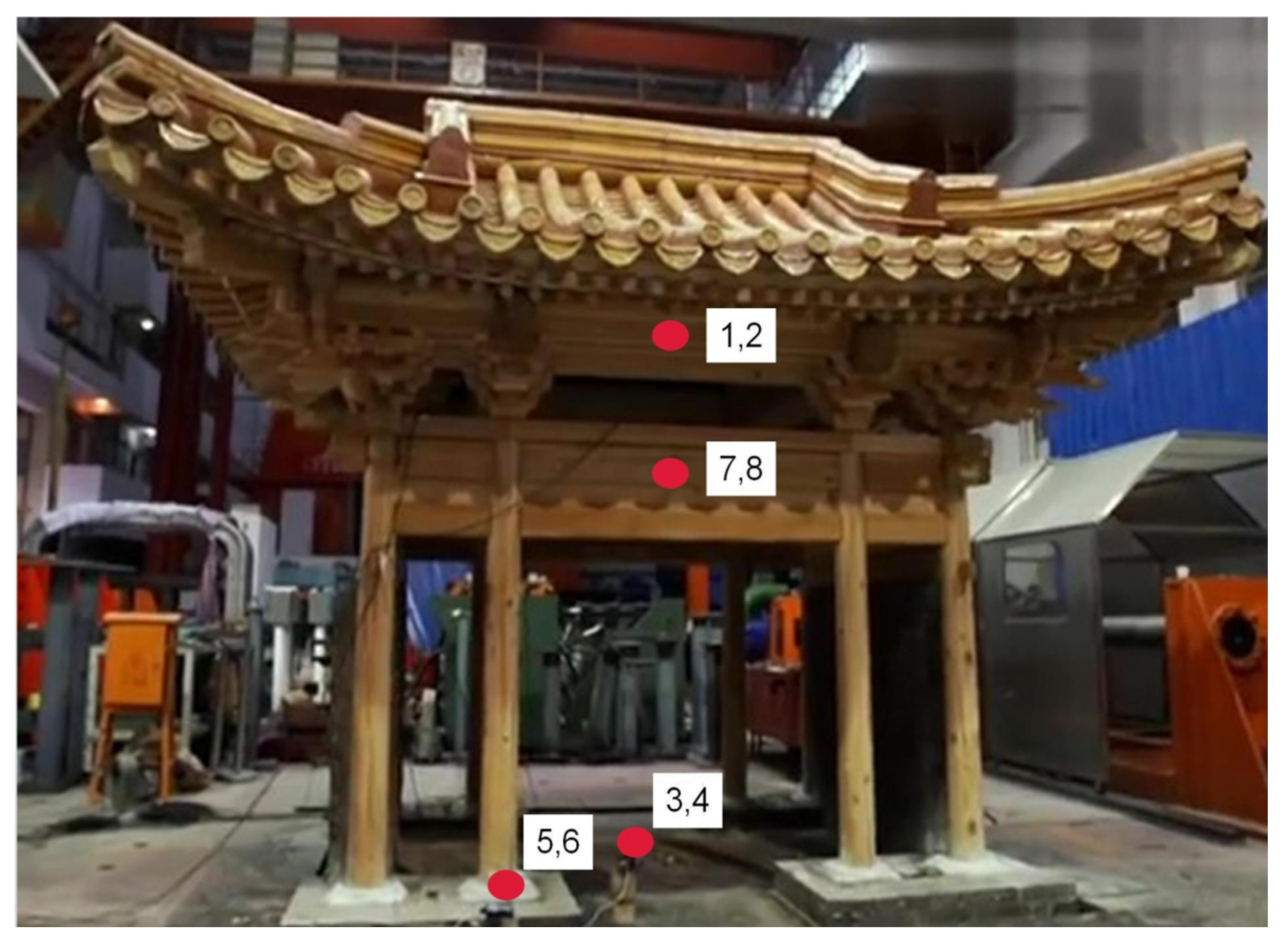
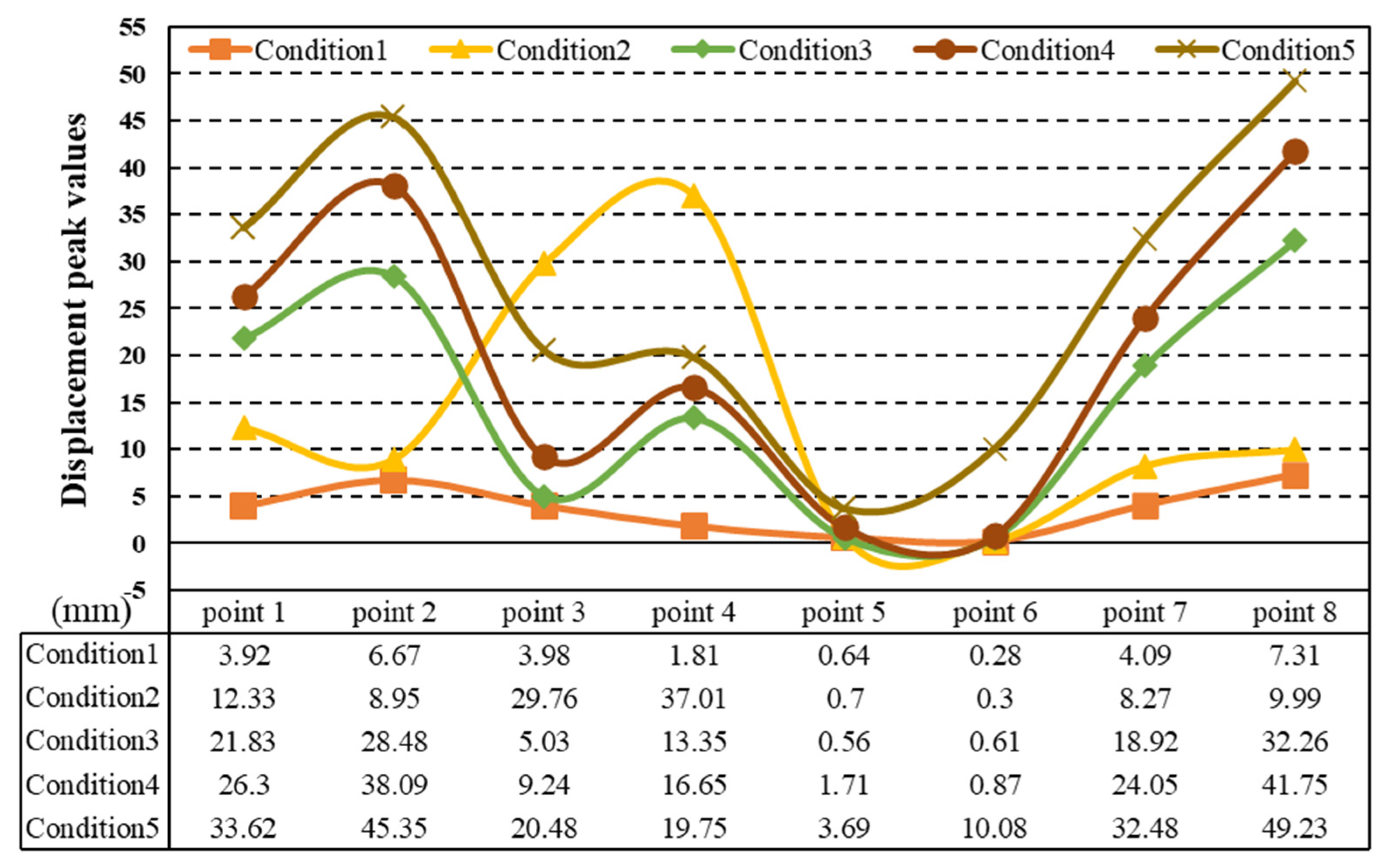
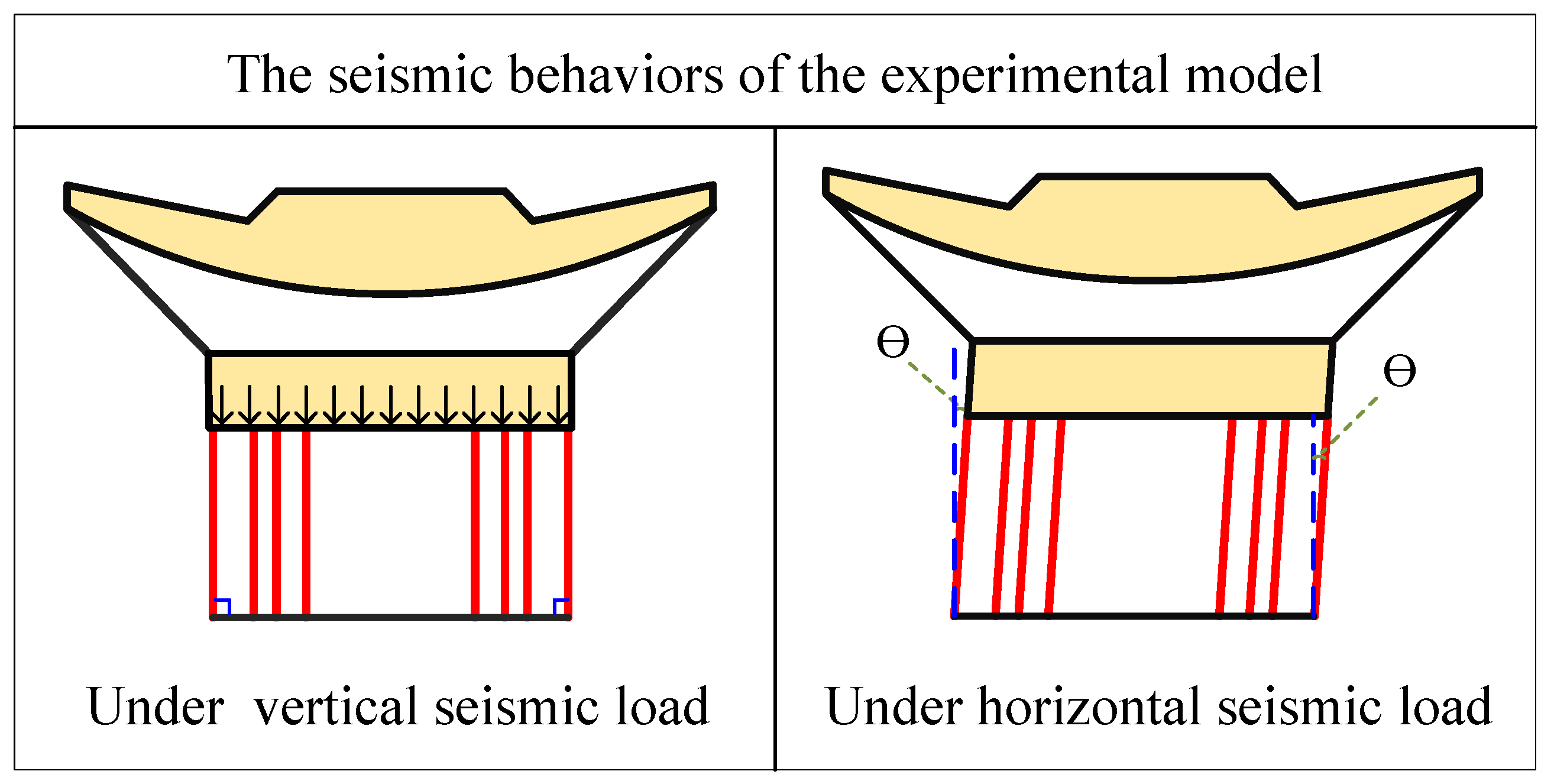


| Condition | Type of Seismic Wave | Load Direction | X toward the Peak Loading Speed/g |
|---|---|---|---|
| 1 | EI-Centro | x, y | 0.10 |
| 2 | EI-Centro | x, y | 0.15 |
| 3 | EI-Centro | x, y | 0.20 |
| 4 | EI-Centro | x, y | 0.25 |
| 5 | EI-Centro | x, y | 0.30 |
Publisher’s Note: MDPI stays neutral with regard to jurisdictional claims in published maps and institutional affiliations. |
© 2022 by the authors. Licensee MDPI, Basel, Switzerland. This article is an open access article distributed under the terms and conditions of the Creative Commons Attribution (CC BY) license (https://creativecommons.org/licenses/by/4.0/).
Share and Cite
Pan, L.; Zhou, M.; Zhuang, H.; Wang, J. Construction Forms and Seismic Performance of the Ancient Chinese Buildings Joined by Tenon–Mortise Joints. Appl. Sci. 2022, 12, 7505. https://doi.org/10.3390/app12157505
Pan L, Zhou M, Zhuang H, Wang J. Construction Forms and Seismic Performance of the Ancient Chinese Buildings Joined by Tenon–Mortise Joints. Applied Sciences. 2022; 12(15):7505. https://doi.org/10.3390/app12157505
Chicago/Turabian StylePan, Linglong, Man Zhou, Haiyan Zhuang, and Juan Wang. 2022. "Construction Forms and Seismic Performance of the Ancient Chinese Buildings Joined by Tenon–Mortise Joints" Applied Sciences 12, no. 15: 7505. https://doi.org/10.3390/app12157505
APA StylePan, L., Zhou, M., Zhuang, H., & Wang, J. (2022). Construction Forms and Seismic Performance of the Ancient Chinese Buildings Joined by Tenon–Mortise Joints. Applied Sciences, 12(15), 7505. https://doi.org/10.3390/app12157505






